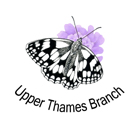 | Butterfly Conservation Saving butterflies, moths and our environment | Upper Thames Branch |  |
Recording Butterflies and Moths |
| Recording observations of butterflies and moths is one of the most valuable ways to assist conservation efforts. Free online national recording systems have been set up to provide for the direct entry of your observations. They allow you to share your observations and have these checked by experts, and to maintain and explore your growing lists of records as maps and graphs. The records sumitted to these online sites feed into databases that are used to understand biodiversity and to influence environmental policy. They can help reveal the impact of environmental changes on our butterfly and moth populations. |
| A "record" can range from the observation of a single butterfly or moth, to a listing of large numbers from a visit to a nature reserve or a moth-trapping session. A record has four essential components: (1) what the species is, (2) where it was seen, (3) when it was seen and (4) who recorded it. Photographs can provide important clues to the identity of the species (and are sometimes essential), and the more detail that you can give (including the number seen, habitat, etc.), the more useful is the record. |
| The recommended online site for your records is iRecord , which allows the recording of all species of wildlife. However, websites with simpler interfaces have also be designed to record specifically butterflies or moths. These are Butterflies for the New Millenium (BNM), and the National Moth Recording Scheme (NMRS). Data submitted using NMRS or BNM are added to iRecord. |
| Documents covering how to get started with these can be accessed below. Thanks to John Thacker for producing these. |
| Getting started with NMRS Getting started with BNM Getting started with iRecord |
Smartphone apps |
| Applications have also have been developed for use with smartphones, enabling the recording of observations of wildlife at the time of sighting with minimal effort. If you take a picture, they make use of image recognition technology to check the identity of the species, and then require a few pieces of information (name of the place, number seen) to complete the record. Using the GPS system on your smartphone the app will calculate your position and provide a grid reference. |
| There are two free apps available, one designed specifically for butterflies (iRecord Butterflies) and one that allows recording of all UK species (iRecord). These can be downloaded from the Apple App Store or Google Play. |
| An introduction to recording moths using the iRecord app, in particular where a list of species is to be recorded, has been kindly supplied by Martin Harvey (see below). |
| Using the iRecord app to record moths |
Copyright © Butterfly Conservation Upper Thames Branch 2024
Privacy and Copyright Statement
Butterfly Conservation : Company limited by guarantee, registered in England (2206468)
Registered Office: Manor Yard, East Lulworth, Wareham, Dorset, BH20 5QP, Tel: 01929 400 209
Charity registered in England & Wales (254937) and in Scotland (SCO39268)
Privacy and Copyright Statement
Butterfly Conservation : Company limited by guarantee, registered in England (2206468)
Registered Office: Manor Yard, East Lulworth, Wareham, Dorset, BH20 5QP, Tel: 01929 400 209
Charity registered in England & Wales (254937) and in Scotland (SCO39268)
